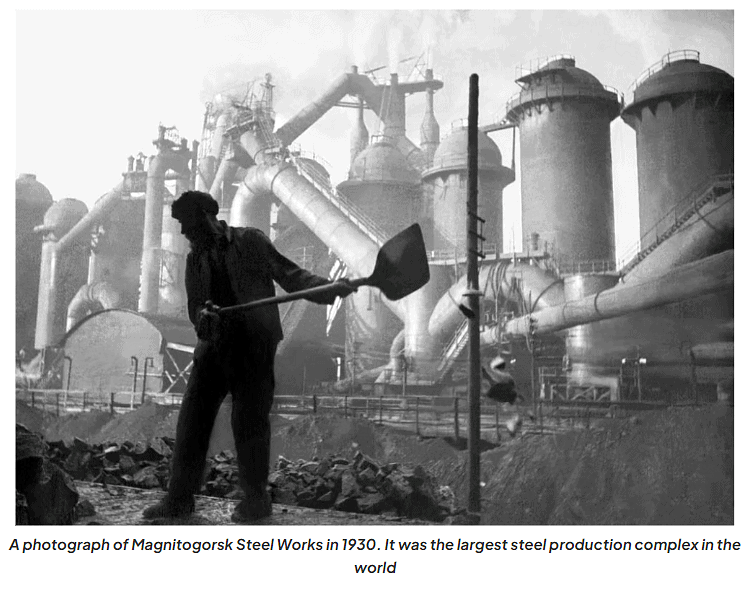Year 11 Exam > Year 11 Notes > History for GCSE/IGCSE > Why Did Stalin Introduce the Five-Year Plans?
Why Did Stalin Introduce the Five-Year Plans? | History for GCSE/IGCSE - Year 11 PDF Download
How Important were the Five-Year Plans - Summary
- The Five-Year Plans were instrumental in shaping the economy and society of Stalin's USSR.
- Stalin's objective was swift industrialization and the attainment of specific economic objectives within five-year cycles, heralding a transformation from an agrarian to an industrial powerhouse.
- Emphasizing heavy industry, infrastructure, and agriculture, Stalin oversaw notable progress in sectors like steel manufacturing and transportation. Yet, the plans exacted a heavy toll, marked by forced labor, famine, and political oppression. Impossibly high targets were set, leading to unattainable goals.
- While contributing to the modernization of the Soviet Union, the Five-Year Plans were marred by significant human and social costs.
Reasons for the Five-Year Plans
- The Five-Year Plans were designed to accelerate industrialization in the USSR.
- Stalin first introduced this concept in 1928.
- There were multiple motivations driving the implementation of the Five-Year Plans.


Details of Stalin's Five-Year Plans
- Stalin initiated the establishment of Gosplan to organize the Five-Year Plan, which was an abbreviation for the 'State Committee for Planning'.
- Targets were set by Gosplan for every region, factory, manager, and worker. These targets were notably ambitious and often unattainable.
- Stalin leveraged foreign aid and investments from nations like Britain and the USA to support the implementation of the plans.
The First Five-Year Plan

The Second Five-Year Plan

The Stakhanovite Movement
- The movement gained momentum during the second Five-Year Plan in 1935.
- Its moniker was derived from Aleksei Stakhanov.
- Stakhanov's purported feat of mining 102 tons of coal in under 6 hours, surpassing his quota by 14-fold on August 31, 1935, garnered widespread attention.
- The communist government lauded Stakhanov's accomplishment, propelling him to national prominence.
- Stakhanov embarked on a nationwide tour as a celebrated figure, with the government providing him a residence, additional wages, and extended vacation time.
- Nationwide competitions were orchestrated by the government to identify top performers in various industries.
- The publicity surrounding Stakhanov inspired others to emulate his example.
- Nikita Izotov reportedly achieved the remarkable feat of mining 640 tons of coal in a single shift on February 1, 1936.
- Stakhanovites emerged across diverse industries, spanning urban and rural locales.
- However, it's likely that Stakhanov and his adherents didn't consistently attain such extraordinary levels of productivity, contributing to inflated expectations and mounting pressure on workers and managers.
Question for Why Did Stalin Introduce the Five-Year Plans?Try yourself: What was the main objective of the Five-Year Plans in Stalin's USSR?View Solution
The Third Five-Year Plan

The document Why Did Stalin Introduce the Five-Year Plans? | History for GCSE/IGCSE - Year 11 is a part of the Year 11 Course History for GCSE/IGCSE.
All you need of Year 11 at this link: Year 11
|
81 videos|86 docs|18 tests
|
FAQs on Why Did Stalin Introduce the Five-Year Plans? - History for GCSE/IGCSE - Year 11
| 1. How did Stalin's Five-Year Plans impact the Soviet Union's economy? |  |
Ans. Stalin's Five-Year Plans significantly transformed the Soviet Union's economy by rapidly industrializing the country, increasing production, and modernizing infrastructure.
| 2. What were some of the main features of Stalin's Five-Year Plans? |  |
Ans. Some of the main features of Stalin's Five-Year Plans included setting production targets, collectivizing agriculture, prioritizing heavy industry, and implementing centralized control over the economy.
| 3. What were the long-term effects of the Five-Year Plans on the Soviet Union? |  |
Ans. The long-term effects of the Five-Year Plans included economic growth, increased industrial output, urbanization, and the emergence of a powerful Soviet industrial complex.
| 4. How did the Five-Year Plans impact the living conditions of Soviet citizens? |  |
Ans. While the Five-Year Plans led to significant economic growth, they also resulted in widespread hardship for many Soviet citizens, including food shortages, poor living conditions, and labor camps for dissenters.
| 5. What were some criticisms of Stalin's Five-Year Plans? |  |
Ans. Some criticisms of Stalin's Five-Year Plans include their heavy focus on heavy industry at the expense of consumer goods, the forced collectivization of agriculture, and the use of harsh methods to achieve production targets.

|
Explore Courses for Year 11 exam
|

|
Signup for Free!
Signup to see your scores go up within 7 days! Learn & Practice with 1000+ FREE Notes, Videos & Tests.
Related Searches

















